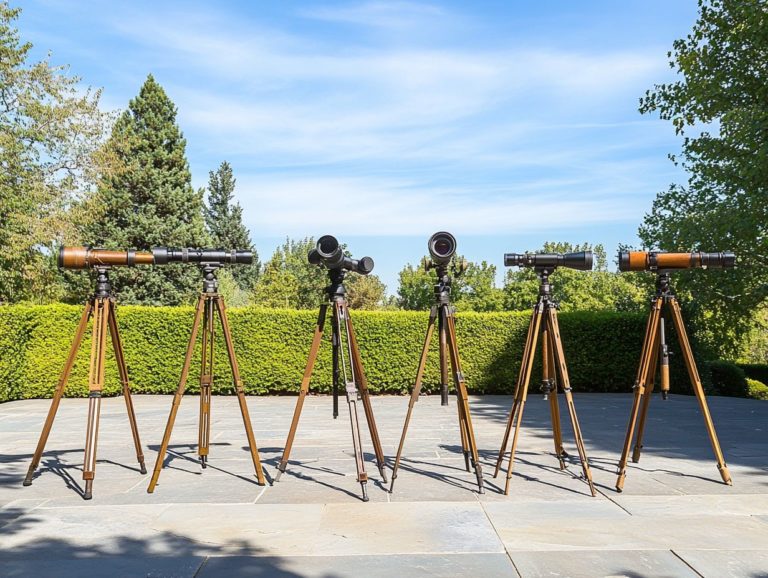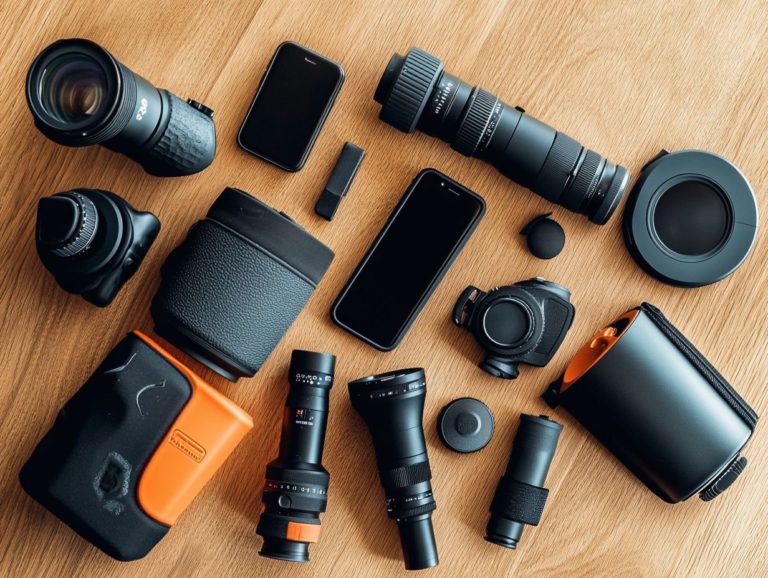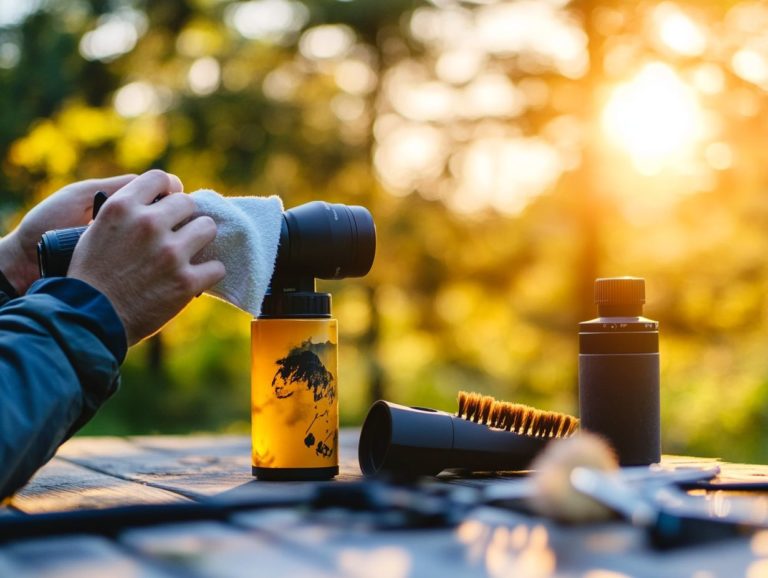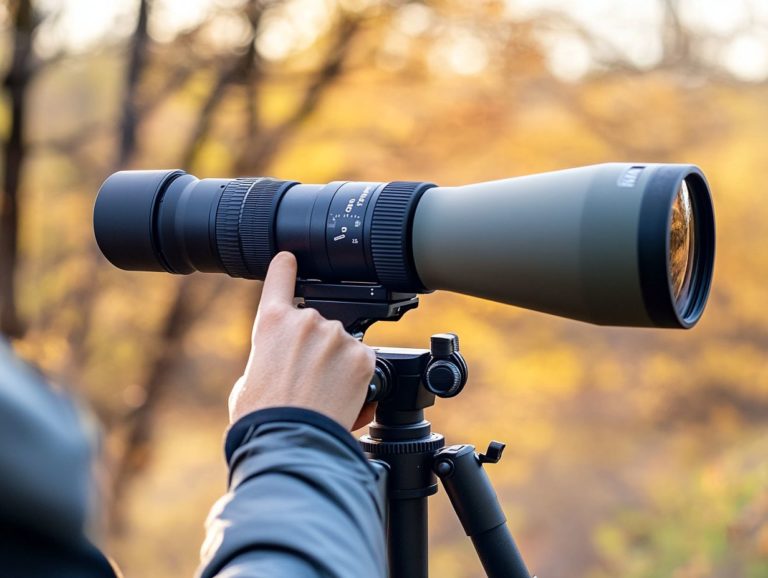Understanding Spotting Scope Specifications
Spotting scopes are essential tools for birdwatchers, hunters, and outdoor enthusiasts like yourself. They grant you the ability to observe distant subjects with remarkable clarity and precision.
This guide delves into the key specifications that determine a spotting scope s performance, such as zoom level and lens size. It compares the benefits of straight and angled designs and emphasizes crucial features like field of view and eye relief. This guide also offers expert purchasing advice on selecting the ideal scope for your specific needs.
Whether you’re just starting out or have years of experience, this information will empower you to make an informed choice about spotting scopes and their best features.
Contents
- Key Takeaways:
- Understanding Magnification and Objective Lens Size
- Types of Spotting Scopes
- Other Important Specifications to Consider
- Choosing the Right Spotting Scope for Your Needs
- Frequently Asked Questions
- What are spotting scope specifications?
- Why is it important to understand spotting scope specifications?
- What is magnification and how does it affect spotting scopes?
- What is objective lens diameter and why is it important?
- What is field of view and how is it measured?
- Can Spotting Scope Specifications Be Customized?
Key Takeaways:
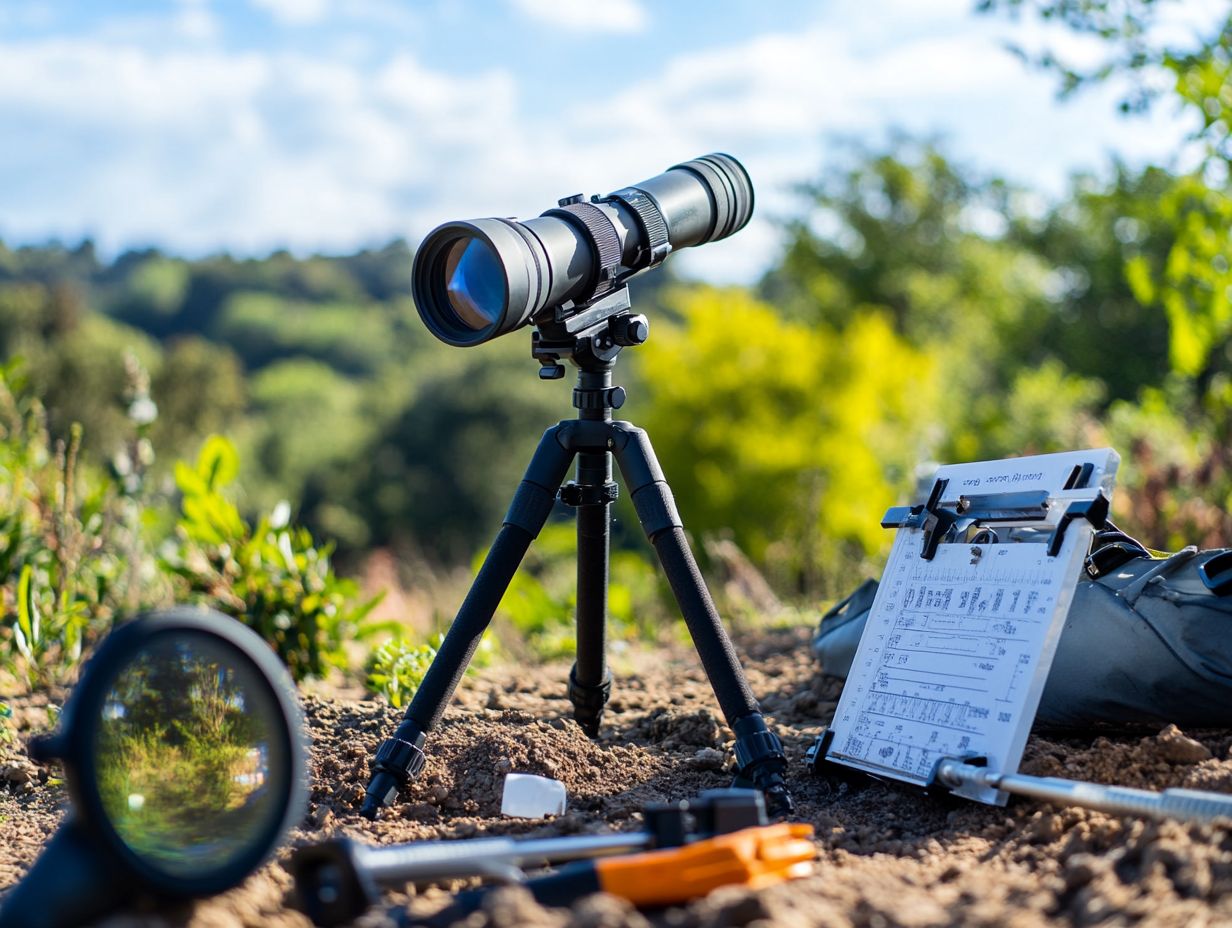
- Understand the relationship between zoom level and lens size to choose the right spotting scope for your nature-watching needs.
- Straight and angled spotting scopes have different advantages, so consider your intended use when deciding on a type.
- Field of view, eye relief, and close focus are important specifications to consider for optimal wildlife viewing performance.
What is a Spotting Scope?
A spotting scope is a premium optical instrument tailored for long-distance viewing. It is particularly cherished by birdwatchers, wildlife enthusiasts, and nature observers who appreciate high-quality optics. Unlike binoculars, which offer a broader field of view, spotting scopes deliver superior magnification and stunning image clarity. This makes them perfect for detailed observation of magnificent birds such as the White-tailed Eagle or the Golden Eagle.
With features like HD glass, ED glass, and BAK-4 glass prisms, these scopes significantly enhance light transmission and visual detail. This ensures that every moment you spend in the field is elevated by exceptional image quality. HD glass enhances color and clarity, while ED glass reduces color distortion.
These fantastic devices shine in low light, making every viewing adventure thrilling. They allow you to see in lower light conditions without sacrificing brightness or contrast. For anyone passionate about wildlife viewing, the advantages of using a spotting scope become abundantly clear. Their refined optics bring distant subjects up close, revealing intricate details that would otherwise go unnoticed, especially when observing birds and other wildlife.
While binoculars are undoubtedly portable and user-friendly for short-range observation, spotting scopes provide a more immersive experience for those eager to study the subtle behaviors and features of wildlife. This combination of enhanced specifications makes spotting scopes a critical tool for serious naturalists like you.
Understanding Magnification and Objective Lens Size
Grasping the intricacies of magnification and objective lens size is essential when selecting a spotting scope. These elements profoundly impact performance across different viewing conditions.
The magnification factor determines how near an object appears. Meanwhile, the size of the objective lens governs the amount of light-gathering power that enters the scope. This ultimately influences the clarity and brightness of the image.
Understanding this interplay will enable you to make an informed choice that enhances your viewing experience. Don t miss out on the chance to see nature up close with a spotting scope!
How Magnification and Objective Lens Size Affect Performance
The performance of your spotting scope hinges on both magnification and the size of its objective lens. Together, they dictate the image quality you ll experience.
Higher magnification allows you to scrutinize subjects closely. Imagine spotting the intricate details of a Peregrine Falcon in flight!
However, it requires a suitably sized objective lens for the best light collection and crisp image clarity.
For example, while a 20x magnification works well for birdwatching in bright conditions, lower light requires a larger objective lens, like an 80mm, to maintain visible detail.
Lower magnification improves stability and expands your field of view. This is especially beneficial when tracking fast-moving wildlife.
Using a 30x magnification can create a more immersive experience when surveying distant landscapes. Just remember it requires precise alignment and steady support to prevent image distortion, especially when taking photos through a spotting scope.
Selecting a scope tailored to your activities is essential. This ensures clarity and detail, no matter your environment or subject.
Types of Spotting Scopes
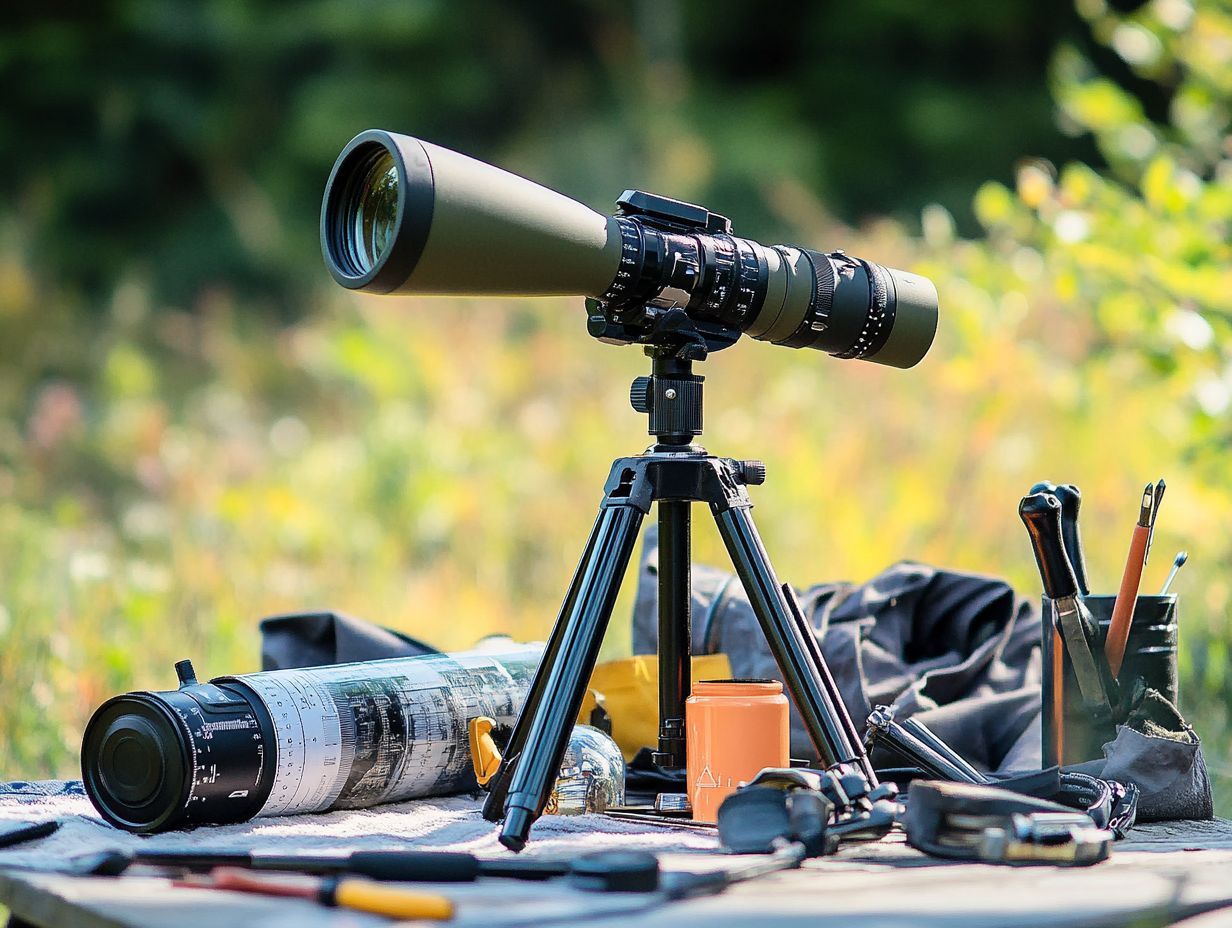
As you explore spotting scopes, discover the two main types: angled spotting scopes and straight spotting scopes. Each caters to different observing needs and comfort levels.
Angled spotting scopes offer comfortable viewing at various angles. They are perfect for extended observations.
Straight spotting scopes resemble traditional binoculars, making them ideal for quick target acquisition and birdwatching.
Understanding these differences helps you select the scope that best suits your needs.
Straight vs. Angled Spotting Scopes
Choosing between straight and angled spotting scopes depends on your personal preferences and the specific scenarios you encounter. Each type offers unique benefits tailored to wildlife viewing.
A straight spotting scope aligns directly with your target, making it easy to glimpse elusive wildlife. An angled design enhances comfort during extended viewing sessions.
This comfort reduces neck strain and allows for versatile tripod mounting options.
Comfort is paramount in your decision-making process. An angled scope provides a relaxed viewing angle, especially in uneven terrain or elevated positions when using a tripod.
Tripod mounts play a crucial role in both designs. Angled scopes provide greater flexibility in height adjustments and viewing angles.
Ultimately, choose between a straight or angled spotting scope based on what you enjoy most, whether it s birdwatching, long-distance target shooting, or enjoying beautiful landscapes.
Other Important Specifications to Consider
Beyond magnification and objective lens size, several specifications influence a spotting scope’s performance. When evaluating options, be sure to consider what to look for in spotting scope durability, including factors like field of view, eye relief, and close focus capabilities.
Understanding these elements helps you choose a scope tailored to your birdwatching needs. This might include identifying distant species or observing feeding behaviors without disturbing wildlife.
Field of View, Eye Relief, and Close Focus
The field of view, eye relief, and close focus enhance your experience with a spotting scope. A wider field of view makes tracking moving subjects easier. Eye relief ensures comfort, especially for glasses wearers. The ability to focus closely allows detailed observations of nearby wonders, like flowers or insects.
Understanding these features helps you enjoy nature’s beauty. A broader field of view captures more of the scene and increases your chances of spotting elusive wildlife.
Eye relief is vital for long viewing sessions. It minimizes eye strain and boosts comfort.
Close focus reveals intricate details of nature, such as a bird s plumage or a butterfly s wings. This enriches your experience and deepens your appreciation for the complexities of the natural world.
Choosing the Right Spotting Scope for Your Needs
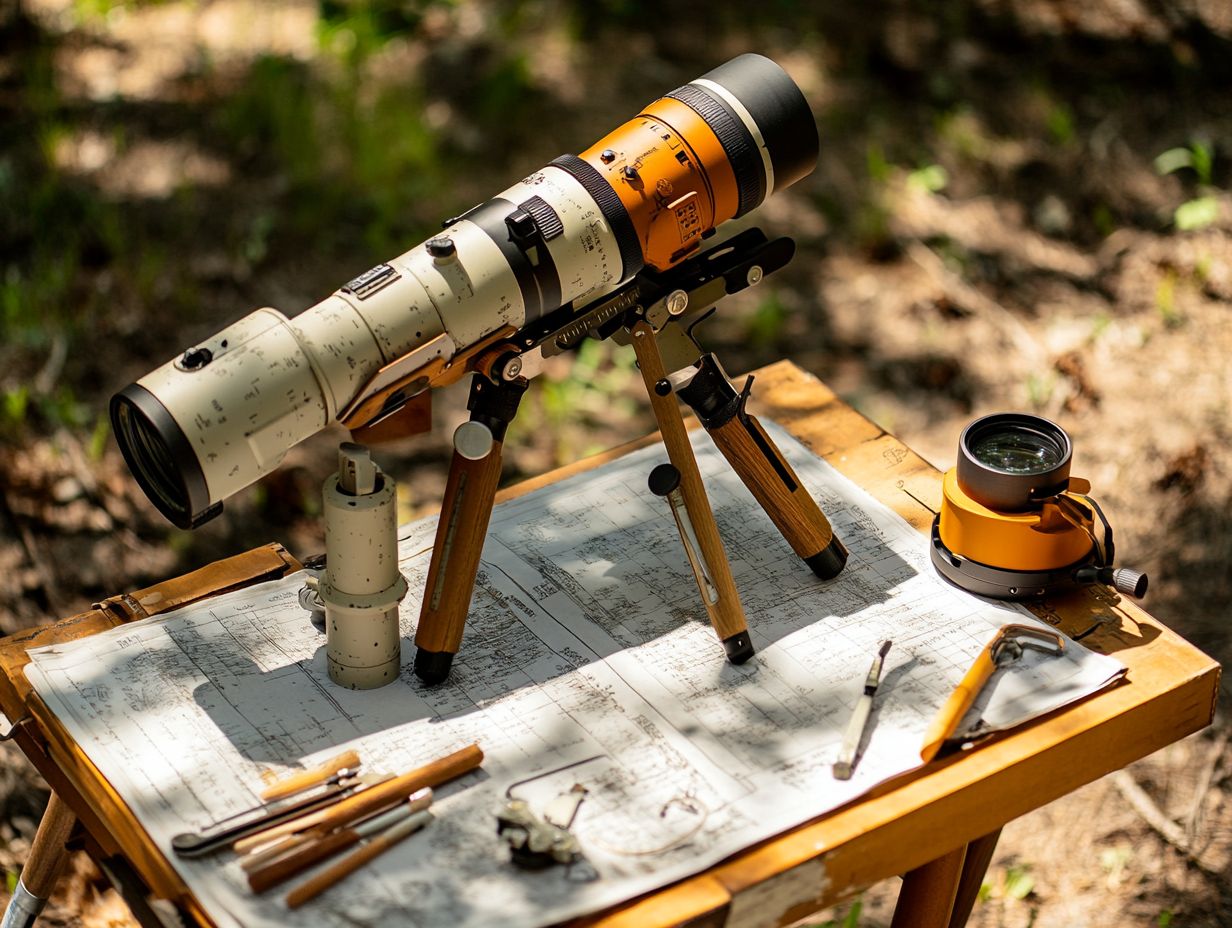
Choosing the right spotting scope requires careful thought. Reflect on your unique needs, the type of wildlife, and the distances you’ll be observing.
Consider essential accessories that can enhance your experience, like tripods, lens cleaning kits, and waterproof scopes for outdoor use. Each element ensures your viewing experience is exceptional.
Factors to Consider and Tips for Decision Making
When selecting a spotting scope, think about the magnification you need for your viewing distance. Determine if you need a waterproof scope and check the quality of the optical equipment for the best image clarity.
Evaluate the scope’s durability since outdoor environments can be unpredictable. Look for sturdy construction and protective coatings to withstand harsh conditions.
The exit pupil influences the brightness of the image, especially in low light. Investing in high-quality optics provides clearer and sharper images.
By considering these factors and reading user reviews, you can confidently choose a spotting scope that meets your needs.
Frequently Asked Questions
What are spotting scope specifications?
Spotting scope specifications detail the features of a spotting scope, which is a type of telescope for observing distant objects. For a deeper insight into these devices, including magnification, objective lens diameter, and field of view, refer to understanding the technology behind spotting scopes.
Why is it important to understand spotting scope specifications?
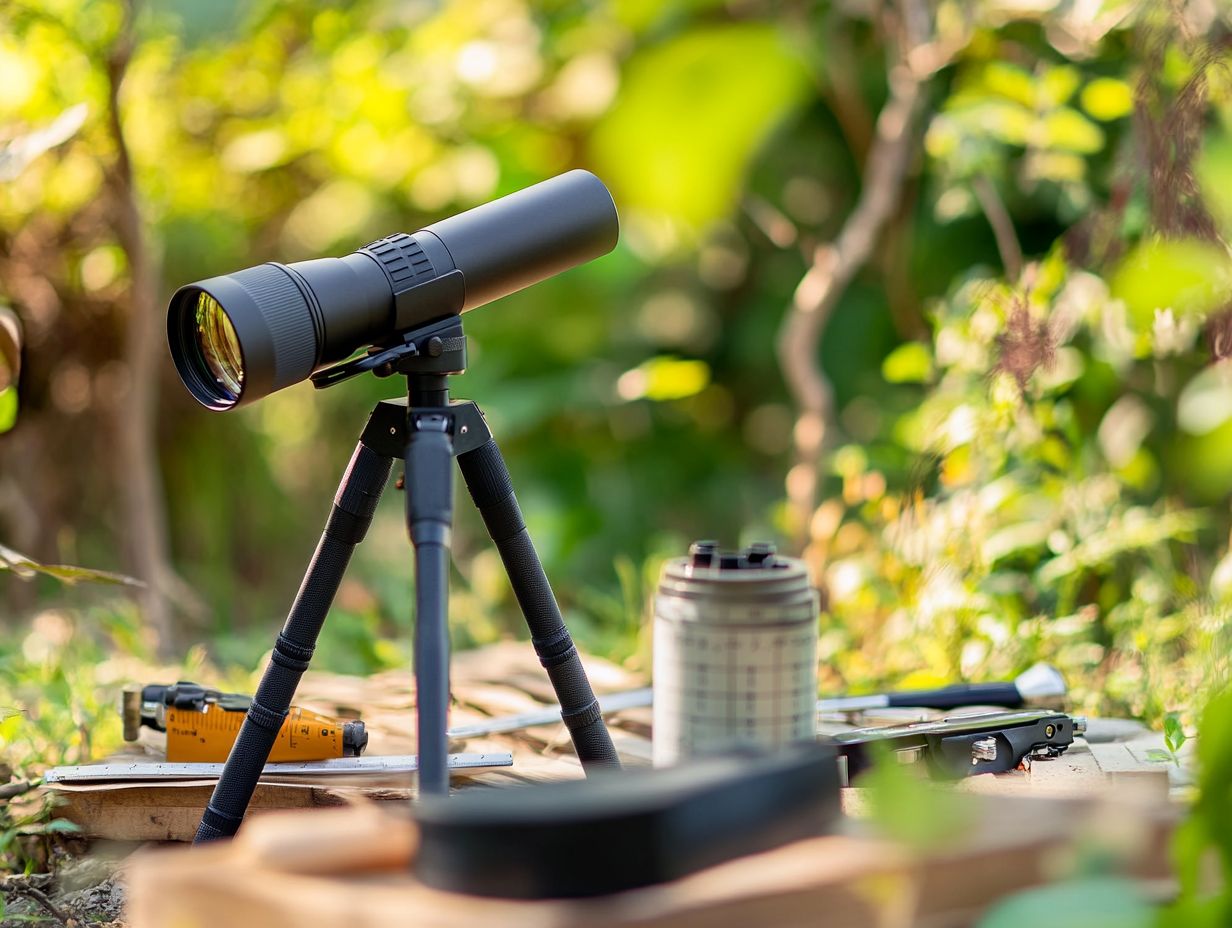
Understanding spotting scope specifications is crucial for selecting the right scope for your needs. For a comprehensive overview, refer to Understanding Spotting Scopes: A Beginner’s Guide, which covers important details like magnification factor and zoom magnification to help you assess the scope’s capabilities and limitations.
What is magnification and how does it affect spotting scopes?
Magnification refers to how much closer a spotting scope can make an object appear. It is typically expressed as a number followed by an “x,” such as 20x.
Higher magnification results in a zoomed-in view but may also lead to a narrower field of view and a darker image. This is essential for activities like nature watching and birdwatching.
What is objective lens diameter and why is it important?
The objective lens diameter is the size of the front lens of a spotting scope, measured in millimeters. This diameter impacts the amount of light that enters the scope, which directly affects image clarity and brightness.
A larger objective lens diameter generally provides a brighter and clearer image, making it critical for wildlife and nature enthusiasts.
What is field of view and how is it measured?
Field of view refers to the observable area through a spotting scope at a given magnification. It’s usually measured in feet or meters and represents the width of the area visible at 1000 yards.
A wider field of view allows you to see a larger area, which is a game-changer for digiscoping and watching fast-moving wildlife!
In conclusion, understanding the specifications of spotting scopes empowers you to make informed choices, especially when considering what to consider when buying a used spotting scope, enhancing your outdoor experiences. Explore your options confidently!
Can Spotting Scope Specifications Be Customized?
Some specifications, like how much larger an object looks (magnification) and the width of the lens that collects light (objective lens diameter), are fixed. However, you can customize features such as eyepieces and tripod mounts.
You can also find spotting scopes with interchangeable lenses for varying magnification levels. This feature is especially useful for achieving optimal clarity in different shooting conditions.

